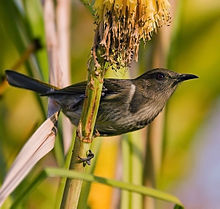
Back Heuningvreters Afrikaans آكلات العسل Arabic آكلات العسل ARZ Meliphagidae AST Proklano (Meliphagidae) AVK Медоядови Bulgarian Meliphagidae Breton Menjamels Catalan Meliphagidae CEB Kystráčkovití Czech
| Honeyeaters | |
|---|---|

| |
| Female crescent honeyeater (Phylidonyris pyrrhopterus) | |
| Scientific classification | |
| Domain: | Eukaryota |
| Kingdom: | Animalia |
| Phylum: | Chordata |
| Class: | Aves |
| Order: | Passeriformes |
| Superfamily: | Meliphagoidea |
| Family: | Meliphagidae Vigors, 1825 |
| Genera[1] | |
|
See text | |
The honeyeaters are a large and diverse family, Meliphagidae, of small to medium-sized birds. The family includes the Australian chats, myzomelas, friarbirds, wattlebirds, miners and melidectes. They are most common in Australia and New Guinea, and found also in New Zealand, the Pacific islands as far east as Samoa and Tonga, and the islands to the north and west of New Guinea known as Wallacea. Bali, on the other side of the Wallace Line, has a single species.[2][3]
In total, there are 186 species in 55 genera, roughly half of them native to Australia, many of the remainder occupying New Guinea.[4][5] With their closest relatives, the Maluridae (Australian fairy-wrens), Pardalotidae (pardalotes), and Acanthizidae (thornbills, Australian warblers, scrubwrens, etc.), they comprise the superfamily Meliphagoidea and originated early in the evolutionary history of the oscine passerine radiation.[6] Although honeyeaters look and behave very much like other nectar-feeding passerines around the world (such as the sunbirds and flowerpeckers), they are unrelated, and the similarities are the consequence of convergent evolution.
The extent of the evolutionary partnership between honeyeaters and Australasian flowering plants is unknown, but probably substantial. A great many Australian plants are fertilised by honeyeaters, particularly the Proteaceae, Myrtaceae, and Ericaceae. It is known that the honeyeaters are important in New Zealand (see Anthornis) as well, and assumed that the same applies in other areas.
- ^ Sibley, C.G. and Monroe, B.L. Jr. (1990). Distribution and Taxonomy of Birds of the World. New Haven: Yale University Press. ISBN 0-300-04969-2.
- ^ Andersen, M.J.; Naikatini, A.; Moyle, R.C. (2014). "A molecular phylogeny of Pacific honeyeaters (Aves: Meliphagidae) reveals extensive paraphyly and an isolated Polynesian radiation". Molecular Phylogenetics and Evolution. 71: 308–315. doi:10.1016/j.ympev.2013.11.014. PMID 24315868.
- ^ Del Hoyo, J., Elliot, A. and Christie D. (editors). (2006). Handbook of the Birds of the World. Volume 12: Picathartes to Tits and Chickadees. Lynx Edicions. ISBN 978-84-96553-42-2
- ^ Gill, Frank; Donsker, David; Rasmussen, Pamela, eds. (2020). "Honeyeaters". IOC World Bird List Version 10.1. International Ornithologists' Union. Retrieved 22 February 2020.
- ^ Hay, Eleanor M.; McGee, Matthew D.; Chown, Steven L. (2022). "Geographic range size and speciation in honeyeaters". BMC Ecology and Evolution. 22 (1): 86. doi:10.1186/s12862-022-02041-6. PMC 9245323. PMID 35768772. S2CID 250147316.
- ^ Barker, F.K.; Cibois, A.; Schikler, P.; Feinstein, J.; Cracraft, J. (2004). "Phylogeny and diversification of the largest avian radiation". Proc. Natl. Acad. Sci. USA. 101 (30): 11040–11045. Bibcode:2004PNAS..10111040B. doi:10.1073/pnas.0401892101. PMC 503738. PMID 15263073.
© MMXXIII Rich X Search. We shall prevail. All rights reserved. Rich X Search